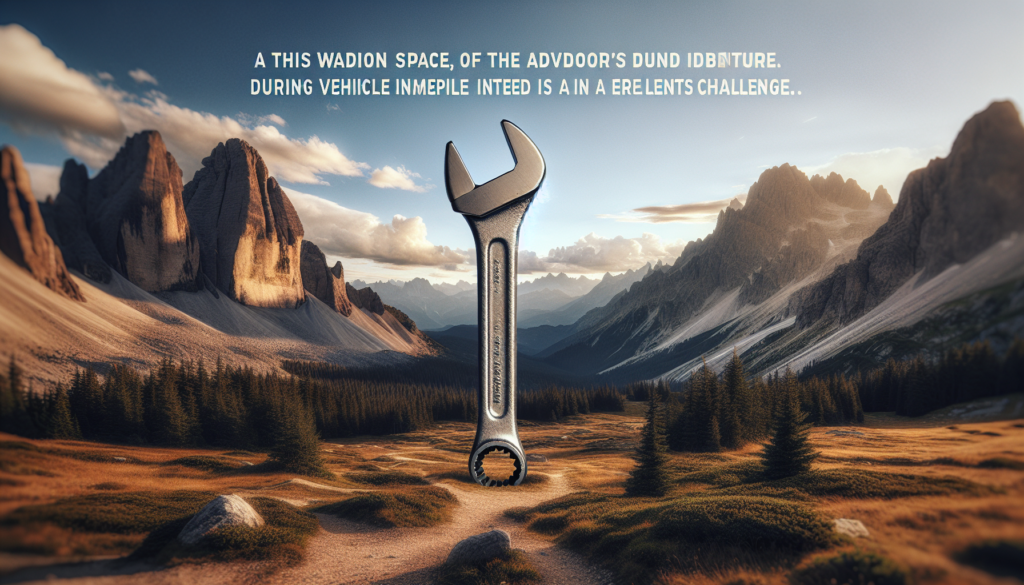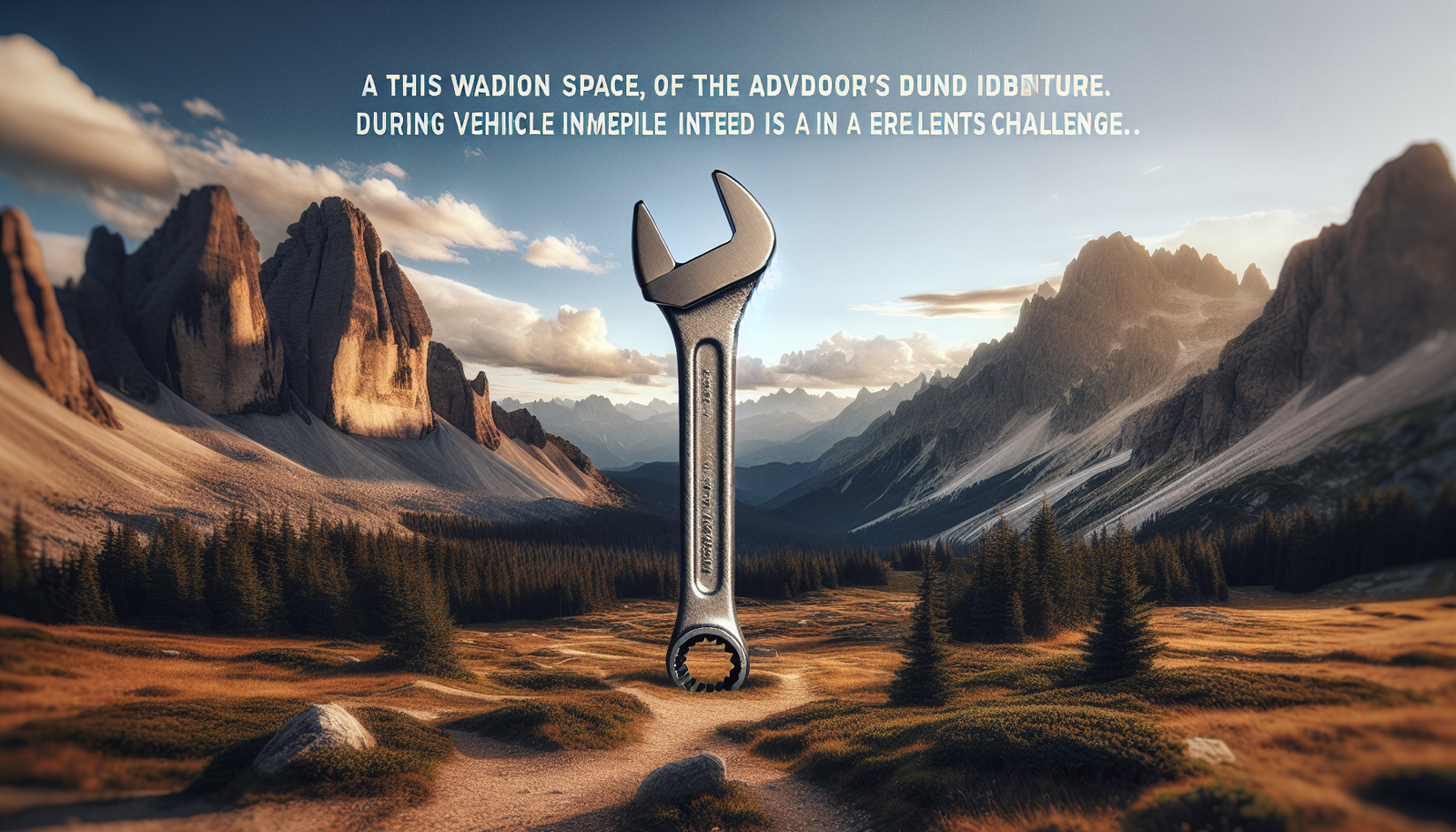Maintaining your vehicle in the field can be a daunting task, but with a few simple tips and tricks, you can ensure that your vehicle stays in optimal condition no matter where your adventures take you. From checking your tire pressure and fluid levels to keeping an emergency kit on hand, these small steps can make a big difference in keeping your vehicle running smoothly and minimizing the risk of breakdowns. So, whether you’re embarking on a rugged off-road trip or simply enjoy the great outdoors, this article will guide you on how to maintain your vehicle in the field and keep it ready for any adventure that comes your way. Maintaining your vehicle in the field is crucial to ensure its longevity and optimal performance. Regular cleaning and washing, monitoring fluid levels, checking and replacing filters, inspecting and maintaining tires, regularly checking and replacing belts and hoses, keeping the battery in good condition, maintaining the cooling system, keeping the brakes in proper working order, regularly inspecting and replacing spark plugs, and maintaining the electrical system are all important aspects of vehicle maintenance. By following these steps, you can keep your vehicle in top shape and avoid potential breakdowns and costly repairs.

Regular cleaning and washing
Exterior cleaning
Keeping the exterior of your vehicle clean not only enhances its appearance but also protects it from dirt, grime, and corrosive elements. Regularly wash your vehicle using a mild car detergent and a soft sponge or microfiber cloth. Pay special attention to areas prone to dirt buildup, such as the wheels, wheel wells, and the undercarriage. Don’t forget to clean the windows and mirrors for optimal visibility.
Interior cleaning
Cleaning the interior of your vehicle is equally important for a comfortable and pleasant driving experience. Start by removing any trash and clutter from the cabin. Vacuum the seats, carpets, and floor mats to remove dust and debris. Use a mild interior cleaner to wipe down surfaces, including the dashboard, steering wheel, and door panels. Don’t forget to clean the windows and mirrors from the inside as well.
Engine cleaning
Regularly cleaning your engine helps remove dirt, grease, and debris that can accumulate over time. However, engine cleaning should be done carefully to avoid damaging sensitive components. Before starting, ensure that the engine is cool. Use a degreaser or engine cleaner spray to loosen dirt and grime. Scrub gently with a soft brush and rinse thoroughly with a hose, being careful to avoid electrical connections and vital engine components. It’s best to consult your vehicle’s manual or seek professional assistance for engine cleaning to ensure safe and effective results.
Monitoring fluid levels
Engine oil
Regularly checking and maintaining the proper engine oil level is vital for the smooth operation and longevity of your vehicle’s engine. Locate the oil dipstick, usually labeled with a bright-colored handle, and pull it out. Wipe it clean with a cloth, reinsert it fully, and then take it out again to read the oil level. If the oil level is below the minimum mark, add the recommended type and amount of oil. Remember to perform oil changes at the recommended intervals to keep your engine running smoothly.
Coolant
Proper coolant levels are essential to prevent engine overheating. Locate the coolant reservoir, usually situated near the radiator, and check the level against the markings on the reservoir. If the coolant level is low, carefully add a mixture of coolant and water according to the manufacturer’s specifications. Be cautious when opening the radiator cap, as the coolant can be hot and pressurized. It’s advisable to check the coolant levels when the engine is cold to avoid any potential injuries.
Transmission fluid
Maintaining the correct level of transmission fluid is crucial for smooth gear transitions and the overall performance of your vehicle’s transmission system. Refer to your vehicle’s manual to locate the transmission fluid dipstick. Similar to checking the engine oil, wipe the dipstick clean, reinsert it, and then remove it again to read the fluid level. If the fluid level is below the recommended mark, add the appropriate type and quantity of transmission fluid to bring it back to the proper level. Regularly changing the transmission fluid as per the manufacturer’s recommendations is also important for the longevity of the transmission system.
Brake fluid
Brake fluid plays a critical role in the functioning of your vehicle’s braking system. Incorrect brake fluid levels can result in compromised braking performance and potentially dangerous situations. Locate the brake fluid reservoir, typically positioned near the firewall on the driver’s side. Check the fluid level against the markings on the reservoir. If the level is low, add the recommended brake fluid while ensuring not to exceed the maximum level indicated. If the brake fluid is excessively dirty or discolored, it may be necessary to have the system flushed and refilled by a professional.
Checking and replacing filters
Air filter
The air filter is responsible for keeping dirt, dust, and debris from entering the engine and affecting its performance. A clogged or dirty air filter can reduce fuel efficiency and hinder engine performance. Consult your vehicle’s manual to locate the air filter housing. Remove the cover and inspect the air filter. If it appears dirty or clogged, it’s time to replace it. A new air filter will ensure proper airflow and protect your engine from harmful contaminants.
Fuel filter
The fuel filter prevents impurities from reaching the engine and potentially causing damage. Over time, the fuel filter can become clogged, impacting fuel flow and engine performance. Refer to your vehicle’s manual to locate the fuel filter and follow the specific instructions for replacement. Regularly replacing the fuel filter, according to the manufacturer’s recommendations, will help maintain optimal fuel efficiency and engine performance.
Oil filter
The oil filter plays an essential role in removing impurities from the engine oil, ensuring its cleanliness and protecting critical engine components. During an oil change, the oil filter should always be replaced. Refer to your vehicle’s manual for the exact location of the oil filter and follow the instructions for replacement, including the correct tightening torque. Regularly replacing the oil filter will help maximize engine performance and prolong the life of your vehicle’s engine.
Cabin filter
The cabin filter is responsible for providing clean and fresh air inside the vehicle’s cabin by filtering out dust, pollen, and other airborne particles. Refer to your vehicle’s manual to locate the cabin filter and follow the instructions for replacement. Regularly replacing the cabin filter will ensure optimal air quality within the cabin and help protect the HVAC system from potential damage.
Inspecting and maintaining tires
Tire pressure
Proper tire pressure is crucial for safe handling, optimal fuel efficiency, and tire longevity. Use a tire pressure gauge to check the pressure of each tire, including the spare. Refer to your vehicle’s manual for the recommended tire pressure. If the pressure is too low, add air until it reaches the recommended level. If it’s too high, release air until it’s within the correct range. Regularly checking and maintaining proper tire pressure will help prevent uneven tire wear and ensure a smooth and safe ride.
Tire tread depth
Inspecting the tire tread depth is important to ensure adequate traction and grip on the road, particularly in wet or slippery conditions. Use a tread depth gauge to measure the depth of each tire’s grooves. If the tread depth is below the recommended limit, it’s time to replace the tires. Worn-out tires can compromise your vehicle’s handling and braking capabilities, increasing the risk of accidents. Regularly checking the tread depth is essential for your safety on the road.
Wheel alignment
Proper wheel alignment ensures that your vehicle’s tires are aligned with each other and the road, resulting in optimal tire wear, fuel efficiency, and handling. If you notice your vehicle pulling to one side or experiencing uneven tire wear, it may be an indication of misalignment. Have a professional perform a wheel alignment to resolve any alignment issues and ensure your vehicle drives straight and handles properly.
Tire rotation
Regularly rotating your tires helps promote even tread wear and extends the overall lifespan of your tires. The specific rotation pattern may vary depending on your vehicle’s drivetrain (front-wheel drive, rear-wheel drive, or all-wheel drive) and tire manufacturer’s recommendations. Consult your vehicle’s manual or seek professional advice to determine the appropriate tire rotation interval and pattern.

Regularly checking and replacing belts and hoses
Serpentine belt
The serpentine belt, also known as the drive belt or accessory belt, drives various components in the engine, such as the alternator, power steering pump, and air conditioning compressor. Over time, the belt may wear out or develop cracks, impacting the functioning of these components. Inspect the serpentine belt for any signs of wear, such as fraying, cracking, or glazing. If you notice any damage or if the belt shows signs of aging, it’s essential to have it replaced promptly to prevent potential breakdowns and damage to other engine components.
Timing belt
The timing belt ensures the synchronization of the engine’s camshaft and crankshaft, enabling proper valve operation. Many modern vehicles have timing belts that require regular replacement at specific mileage intervals. Consult your vehicle’s manual to determine the recommended timing belt replacement schedule. Replacing the timing belt according to the manufacturer’s guidelines is crucial, as a failure can result in significant engine damage.
Radiator hoses
Inspecting the radiator hoses is important to ensure they are in good condition and free from leaks or cracks. Over time, hoses can deteriorate due to heat and age, potentially resulting in coolant leaks and engine overheating. Inspect the radiator hoses for any signs of damage or wear, such as bulges, cracks, or soft spots. Replace any damaged hoses promptly to maintain proper cooling system function and prevent potential engine damage.
Keeping the battery in good condition
Cleaning the terminals
The battery terminals can accumulate corrosion, which can hinder proper electrical conductivity and impact battery performance. To clean the terminals, disconnect the battery by removing the negative (black) cable first, followed by the positive (red) cable. Use a mixture of baking soda and water or a battery terminal cleaner solution to clean the terminals and cable ends. Scrub gently with a wire brush or battery terminal cleaner tool to remove any corrosion. Rinse with water and dry thoroughly before reconnecting the battery. Regularly cleaning the terminals will ensure a reliable electrical connection and prolong battery life.
Checking the charge
Monitoring the battery charge level is important to prevent unexpected battery failures. Use a multimeter or battery tester to measure the battery’s voltage. A healthy battery should typically read around 12.6 volts. If the voltage is significantly lower, it may indicate a weak or discharged battery that requires charging or replacement. Additionally, have your battery tested regularly by a professional to assess its overall health and performance.
Replacing if necessary
Batteries have a limited lifespan, usually around 3-5 years. If your battery no longer holds a charge or consistently fails to start your vehicle, it may be time for a replacement. Consider your vehicle’s specific requirements, such as battery size and cold-cranking amps (CCA), when selecting a new battery. Follow the manufacturer’s guidelines and safety instructions when replacing the battery, or have a professional perform the replacement for you.
Maintaining the cooling system
Flushing and refilling coolant
Regularly flushing and refilling the coolant in your vehicle’s cooling system helps prevent overheating and potential engine damage. Over time, coolant can become contaminated and lose its effectiveness. Consult your vehicle’s manual to locate the radiator drain plug or petcock and follow the instructions for draining the coolant. Once drained, refill the cooling system with the appropriate coolant mixture recommended by the manufacturer. It’s essential to use the correct coolant type and follow the specified mixing ratios to ensure optimal performance and protect against freezing or boiling.
Inspecting radiator and hoses
Inspecting the radiator and hoses is crucial to identify any leaks, cracks, or damage that could lead to coolant loss or overheating. Check the radiator for signs of corrosion, leaks, or bent fins that can impact cooling efficiency. Additionally, inspect the radiator hoses for any signs of bulging, cracking, or soft spots. Replace any damaged components promptly to maintain proper cooling system function and prevent potential engine damage.
Keeping the brakes in proper working order
Checking brake pads and rotors
Regularly inspecting the brake pads and rotors is essential to ensure safe braking performance. Check the brake pads for signs of excessive wear, such as thinning or uneven pad thickness. Additionally, inspect the brake rotors for any signs of scoring, warping, or uneven wear. If you notice any significant wear or damage, it’s crucial to have the brake pads and rotors replaced promptly to maintain optimal braking efficiency and safety.
Bleeding the brake system if needed
Bleeding the brake system helps remove air pockets that can compromise brake performance and pedal feel. If you notice a spongy or soft brake pedal, it may indicate the presence of air in the brake lines. Consult your vehicle’s manual for the proper bleeding procedure, as it may vary depending on the brake system design. Alternatively, have a professional perform the brake system bleeding to ensure proper execution and safe operation.
Regularly inspecting and replacing spark plugs
Checking spark plug condition
Spark plugs play a vital role in igniting the air-fuel mixture within the engine cylinders. Monitoring the condition of the spark plugs is important to ensure optimal engine performance and fuel efficiency. Remove the spark plugs using a spark plug socket and inspect them for signs of wear, such as fouling, excessive carbon buildup, or erosion. If the spark plugs show significant wear or damage, it’s essential to replace them with new ones according to the manufacturer’s recommendations.
Replacing spark plugs if necessary
Regularly replacing spark plugs at the recommended interval is crucial for maintaining optimal engine performance. Follow the manufacturer’s guidelines for selecting the correct spark plug type and ensure you have the necessary tools to remove and install the spark plugs correctly. Properly gapped and functioning spark plugs help promote efficient fuel combustion, smooth engine operation, and reduced emissions.
Maintaining the electrical system
Checking and replacing fuses
The electrical system in your vehicle comprises various fuses that protect individual circuits from electrical faults and overloads. Regularly check the fuses to ensure they are intact and functioning correctly. If a fuse is blown, replace it with a new fuse of the correct amperage rating. Refer to your vehicle’s manual or fuse box cover for the specific fuse locations and amperage ratings.
Inspecting and replacing bulbs
Regularly inspecting your vehicle’s bulbs is important for optimal visibility and safety on the road. Check all exterior lights, including headlights, taillights, brake lights, turn signals, and license plate lights, to ensure they are functioning correctly. Replace any burned-out bulbs promptly using the appropriate bulb type and specifications. Properly working bulbs help improve visibility for both you and other drivers, reducing the risk of accidents.
By following these comprehensive steps for maintaining your vehicle in the field, you can keep your car in excellent condition and ensure reliable performance. Regular cleaning and washing, monitoring fluid levels, checking and replacing filters, inspecting and maintaining tires, regularly checking and replacing belts and hoses, keeping the battery in good condition, maintaining the cooling system, keeping the brakes in proper working order, regularly inspecting and replacing spark plugs, and maintaining the electrical system are all essential aspects of vehicle maintenance. By dedicating time and effort to these tasks, you can prolong the life of your vehicle, reduce the risk of breakdowns, and enjoy a safe and comfortable driving experience.

